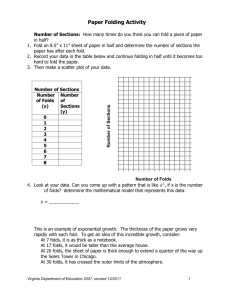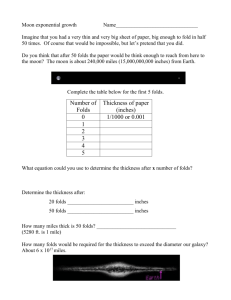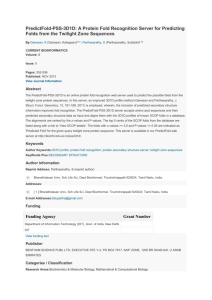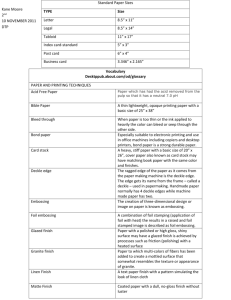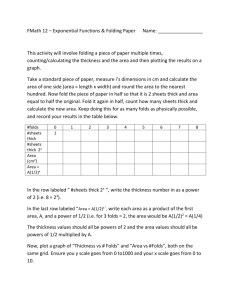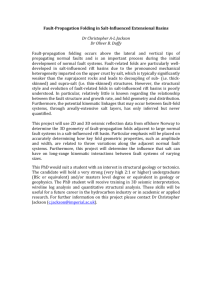WORD
advertisement
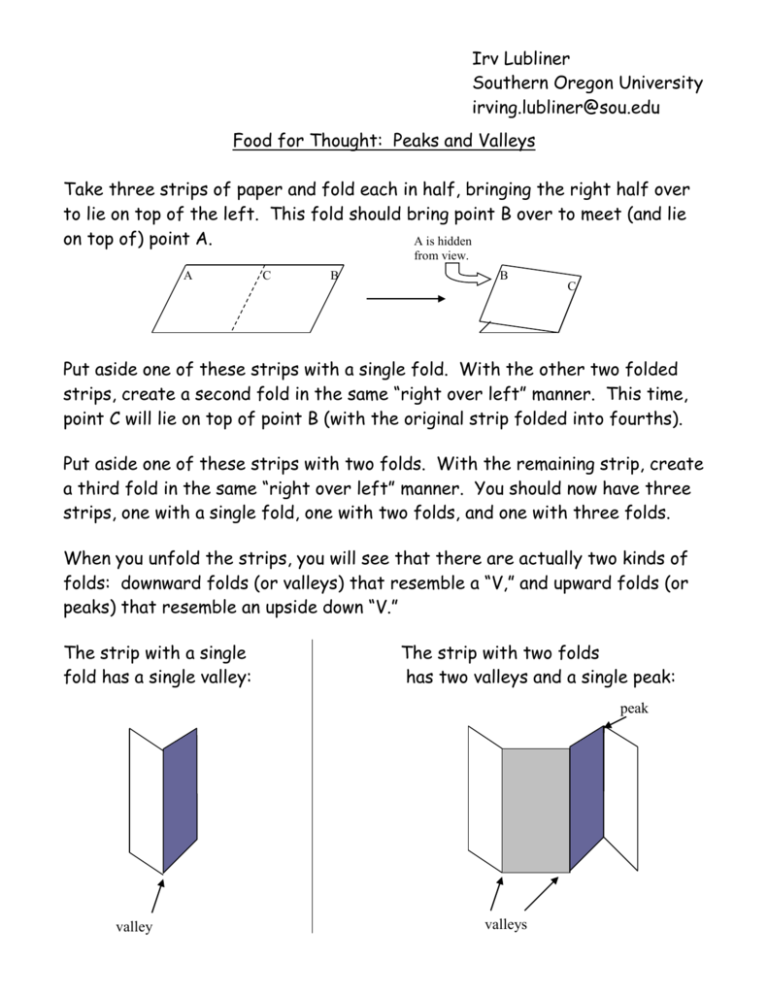
Irv Lubliner Southern Oregon University irving.lubliner@sou.edu Food for Thought: Peaks and Valleys Take three strips of paper and fold each in half, bringing the right half over to lie on top of the left. This fold should bring point B over to meet (and lie on top of) point A. A is hidden from view. A C B B C Put aside one of these strips with a single fold. With the other two folded strips, create a second fold in the same “right over left” manner. This time, point C will lie on top of point B (with the original strip folded into fourths). Put aside one of these strips with two folds. With the remaining strip, create a third fold in the same “right over left” manner. You should now have three strips, one with a single fold, one with two folds, and one with three folds. When you unfold the strips, you will see that there are actually two kinds of folds: downward folds (or valleys) that resemble a “V,” and upward folds (or peaks) that resemble an upside down “V.” The strip with a single fold has a single valley: The strip with two folds has two valleys and a single peak: peak valley valleys Using the number 1 to represent a valley and 0 to represent a peak, we see that the sequence of folds can be written as follows: After one fold: After two folds: 1 110 By folding additional strips and/or observing patterns, determine the sequence of valleys and peaks for each of the following: After three folds: _________________________________________ After four folds: _________________________________________ After five folds: _________________________________________ After six folds: _________________________________________ =============================================================================== Questions: 1) How many digits are in the sequence for N folds? 2) Looking at the sequences for both N and N+1 folds, what can be said about the digits in the even-numbered positions (the 2nd digit, the 4th, the 6th, etc.)? What can be said about the digits in the odd-numbered positions? Can you explain those observations in terms of the folded paper? 3) Notice that the entire sequence for N folds always appears at the beginning of the sequence for N+1 folds. Why does this occur? 4) If it were possible to fold a strip of paper 100 times and you created the sequence of valleys (1’s) and peaks (0’s), what would be its 88th digit? 5) Tommy the Tortoise moves one unit from left to right and then stops, awaiting further instructions. We can use “peak and valley” sequences to provide Tommy with turning instructions. We will let 1’s indicate left turns, and 0’s will indicate right turns. Tommy moves 1 unit in the new direction after each turn. Thus, the single fold sequence results in a left turn: The two-fold sequence results in two left turns, then a right: What do the paths look like when there are even more folds? Answers: 1) After N folds, the sequence has (2N – 1) digits. 2) Consider the third sequence, 1101100. All of the folds present after three folds are still there after four folds, but new folds are created between each neighboring pair. Thus, that same string of digits will appear in the even-numbered positions of the fourth sequence. Thus, the fourth sequence will have this form: _1_1_0_1_1_0_0_ The blanks will be filled with alternating 1’s and 0’s, like this: 110110011100100 How would you explain why the odd-numbered positions are filled in that manner? The same phenomena occurs when we look at any fold sequence and its successor. 3) After N+1 folds, the left half of the strip will have the same fold pattern as was seen on the entire strip had after just N folds. Thus, the fold sequence for N folds will appear at the start of the sequence for N+1 folds. The fold sequence for N+1 folds can be thought of as having three parts: the fold sequence for N folds, followed by a 1 (representing the very first valley formed when the original strip was first folded), and the first portion written backwards, with each 1 changed to a 0 and each 0 changed to a 1. Can you explain, in terms of the folded strip of paper, why the third part can be described that way? 4) Because of the phenomena described above for question 2, the mth digit in a given fold sequence will always become the (2m)th digit in the subsequent sequence. Thus, the 88th digit of the 100th sequence was the 44th digit of the 99th sequence, the 22nd digit of the 98th sequence, and the 11th digit of the 97th sequence. The 97th sequence can be created by inserting alternating 1’s and 0’s between consecutive digits in the 96th sequence. Doing this, a 1 becomes the 1st digit of the 97th sequence, a 0 becomes its 3rd digit, a 1 becomes the 5th digit, a 0 becomes the 7th digit, a 1 become the 9th digit, and a 0 becomes the 11th digit. Thus, the 88th digit of the 100th fold sequence is a 0. 5) The fold patterns create a fractal, known as the “Dragon Curve.” No folds: Four folds: One fold: Two folds: Five folds: Seven folds (reduced in size): Nine folds (reduced in size again): Three folds: Six folds: Eight folds: Ten folds: Eleven folds: Twelve folds: Thirteen folds (reduced in size again): You might recognize this fractal pattern from the book Jurassic Park by Michael Crichton. Each chapter of that book begins with a diagram showing one of the iterations of this pattern.

